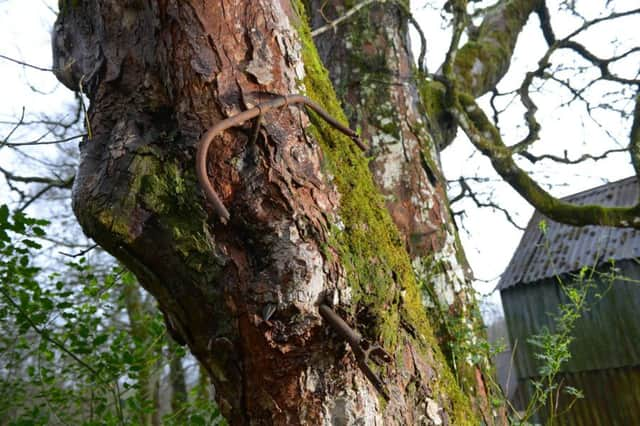“Metal-eating” Trossachs tree given protected status


The century-old Bicycle Tree, close to the site of a former blacksmith’s shop in Brig O’Turk in the Trossachs is renowned for its unusual features - particularly the bicycle handlebars and part of a frame which appear to grow out of the trunk.
It is also thought that a ship’s anchor and chain, and parts of a horse’s bridle may also have been “swallowed up” by the sycamore’s expanding trunk.
Advertisement
Hide AdAdvertisement
Hide AdThe tree is thought to have self-seeded, sometime in the late 1800s.
It then grew through the blacksmith’s scrapheap enveloping and taking with it dozens of small pieces of metal. Many were swallowed whole and are no longer visible protruding through the bark.
Larger articles including the bicycle and anchor were consumed later as the “ironivorous” tree became a “local celebrity”.
According to legend, the blacksmith himself would often use the tree to prop up or suspend unused bits of ironmongery. Over time the tree enveloped them too.
The bicycle is believed to have belonged to a villager conscripted during World War I who left it hanging on a branch and either never returned for it or found it engulfed by the tree when he did.
Loch Lomond and the Trossachs National Park confirmed today that it had made a Provisional Tree Preservation Order for the tree, at Dorothy’s Field, Brig o’Turk, around half a mile north of the village on the Glenfinglas road.
A spokeswoman said: “The mature Sycamore (Acer pseudoplatanus) has significant cultural and historic heritage which is recognised locally, regionally and nationally.
“The tree has been recorded on a number of veteran tree surveys such as Loch Lomond and the Trossachs Countryside Trust 2013 and Woodland Trust ‘Ancient Tree Hunt’ 2009.”
Advertisement
Hide AdAdvertisement
Hide AdThe Park Authority says a tree presevation order would protect the tree in the event of any future change in land use in the area.
Campaign
A campaign to protect the tree was launched in 2007 by local author John Barrington, who said the tree was “one of the great wonders” and “a freak of nature”.
He said: “The tree has stood for more than 100 years.
“The seedling grew up through this pile of scrap metal, on which the local blacksmith had thrown all kinds of things.
“As it grew it swallowed up and took with it hundreds of bits and pieces of metal.
“As it became stronger, the blacksmith would prop up or hang various articles such as the anchor on a heavy chain which he would leave or forget about.
“Gradually, even after the blacksmith passed away, the tree absorbed them too.
“A link of the chain would have been caught on an early branch and, as the limb grew, it became strong enough to lift it.
“There is a story about a villager conscripted to the Great War who left his bicycle over a branch.
Advertisement
Hide AdAdvertisement
Hide Ad“Perhaps he never returned, or perhaps on his return he found that the tree had claimed the bicycle as its own.
“Today all that remains sticking out of the trunk are the handle bars and the wheel forks.”
The tree has long outlived the blacksmith, Hugh MacGregor, who died in 1923 aged 82, after 48 years in Brig o’ Turk. He is buried in a small graveyard nearby.
Villagers say that had the smiddy still been active, the tree would undoubtedly have been killed by now, but it has been allowed to grow unhindered.
Sycamore is known as “a very amenable wood”, often used to craft items such as shepherds’ crooks. The tree’s metal “diet” has done it no
no harm at all, according to experts.
Arboroculturalist Donald Rodger said it was “a unique novelty” and “a great part of our natural heritage”.
The small village of Brig o’ Turk, seven miles west of Callander, is famous
for its list of visitors.
They have included most of the Scots kings, who hunted deer in nearby Glen Finglas forest, Queen Victoria, William Wordsworth, Sir Walter Scott, and the pre-Raphaelite artist John Millais who painted John Ruskin, the 19th century art critic and socialist, at a waterfall nearby.
The nearby Brig o’ Turk Tea Room also featured in the 1959 film The 39 Steps, starring Kenneth More.
